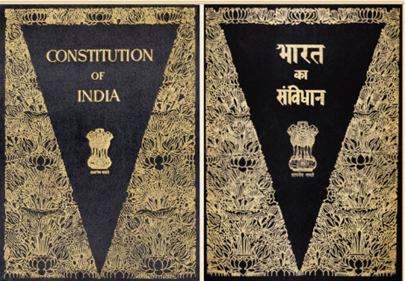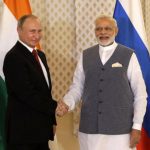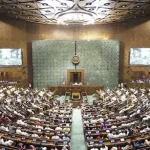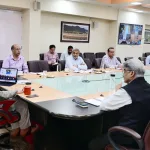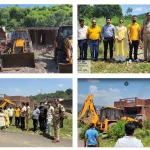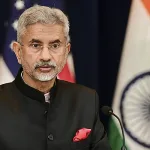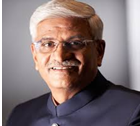
India is a living experience of culture and historical legacy. It is difficult to express history in simple terms. It is even more daunting a task to express more than five thousand years of civilizational history visually on a visionary document that would guide the fortunes of a newly independent nation around the time of independence. But Acharya Nandalal Bose was not just another artist and the illustrations on the Constitution of India was not just another project. His vision for the illustrations in the Constitution chronicles the journey of Bharat from the time of the Harappan civilization to the doorstep of freedom at last.
All the illustrations are listed on the last page of the Constitution and are categorized into twelve historical periods: Mohenjodaro Period, Vedic Period, Epic Period, Mahajanpada and Nanda Period, Mauryan Period, Gupta Period, Medieval Period, Muslim Period, British Period, India’s Freedom Movement, Revolutionary movement for freedom and Natural Features.
The Constitution commences with an illustration of our National Emblem. Nandalal Bose was very particular about wanting the lions in the emblem to look exactly like the real lions with the correct movement and facial expressions and variations across age. Dinanath Bhargava, designer of the National Emblem, who was then a young student at Kala Bhavan visited the Kolkata Zoo for months to study lions for their expressions, body language and mannerisms before illustrating this artwork.
The Preamble page and many other pages were designed by Beohar Rammanohar Sinha. Nandalal Bose endorsed Sinha’s artwork for the Preamble without any alteration whatsoever. The page bears Sinha’s short signature Ram in Devanagari in the lower-right corner. The Preamble is a handwritten text encircled with a rectangular border. There are four animals depicted in the four corners of the border. The four animals depicted are taken from the base of the national emblem of India. The lotus motif features prominently in the border artwork.
Each part of the Constitution begins with an illustration and different pages depict distinct border designs. The signatures of the artists are visible on the illustrations and near the border indicating the collaborative nature of the project. Many of the pages bear multiple signatures which appear either in Bengali, Hindi, Tamil and English. Part 19 of the Constitution of India dealing with Miscellaneous features a portrait of Netaji saluting in military attire surrounded by his troops.
Nandalal Bose’s signature appears on the illustration and A. Perumal’s signature is visible on the left bottom corner of the page.He became well-known as the artist who took art to the people. He would go around the villages of Santiniketan and decorate the walls of the Santhal homes with nature themes full of animals, birds and trees. He lived and worked with great artists like Nandalal Bose for over four decades in Kala Bhavan of Shantiniketan and was affectionately called ‘Perumalda’.
Part VI of the Constitution, which deals with The States in Part A of the First Schedule, commences with a richly colored piece of art of the meditating Mahavir seated cross-legged with his eyes closed and palms resting on each other. There are two trees in bloom, one on each side of Mahavir and a peacock is also visible in the frame indicating a harmonious coexistence in a natural setting. This is one of the few colored images in the original constitution. The colorful illustration bears the signatures of Jamuna Sen and Nandalal Bose. The border design on this page bears the signature of artist named Rajniti.
Part 15 of the Constitution of India focuses on Elections. The illustrations on this page feature two brave sons of India, Chhatrapati Shivaji Maharaj and Guru Govind Singh. The illustrations on this page have been done by Dhirendra Krishna Deb Burman who was a member of the Tripura Royal family and had close ties with Rabindranath Tagore and Nandalal Bose. The border design carries the signature of Kripal Singh Shekhawat who was a renowned artist and ceramist of India, known for reviving the art of the iconic Blue Pottery of Jaipur.
Kala Bhavan the fine art institute in Santiniketan attracted students and artists from all corners of India and the world thus creating a thriving ecosystem of relentless pursuit of excellence amalgamating various influences but, in the end, creating an unique Indian style and narrative of artistic vision. Many of the artists who worked on the project went on to achieve great heights in their careers but at the time of this project they were students and collaborators at Santiniketan eager to bring to life the vision of their revered ‘master moshai’ Nandalal Bose.
The inspirations for the illustrations in the Constitution are anchored in the vast history, physicallandscape, mythological tapestry and freedom struggle of Bhart. Part 13 of the Constitution of India deals with ‘Trade, Commerce and Intercourse within the Territory of India’ The illustration on this page is a scene taken from bas relief forms which is part of the Group of Monuments at Mahabilapuram an UNESCO inscribed World Heritage Site.‘Descent of the Ganges’ refers to a large, open-air rock relief sculpture that depicts in stone the myth of the Ganges River descending from heaven to earth. Nandalal Bose’s signature appears on the illustration and Jamuna Sen’s name appears on the left bottom corner of the border.
Part 3 which deals with Fundamental Rights features a scene from Ramayana. The border on this page bears the signature of Jamuna Sen. Part 4 dealing with dealing with Directive Principles of State Policy features a scene from Mahabharata. The names of Bani Patel and Nandalal Bose appear on the illustration at the right bottom and Vinayak Shivaram Masoji’s name appear on the left corner of the border
Part 7 of the Constitution deals with the ‘The States in Part B in the First Schedule’. The illustration at the start of this segment depicts the spread of Buddhism by Emperor Ashoka. He is shown riding an elephant which is decorated with all the finery and is surrounded by Buddhist monks.The illustration is in the style of Ajanta, with the monks depicted with bare chests and jewellery.
This illustration was done by Nandalal Bose, whose work was deeply influenced by the artistic traditions found in the Ajanta frescoes. A Perumal’s name is also visible on the lower left of the illustration.The border design carries the signature of Beohar Rammanohar Sinha who also designed the Preamble and many other pages. Here he signs as Rammanohar in Hindi. This is one of the only pages in the Constitution that carries the names of both Nandalal Bose and his senior most student Beohar Rammanohar Sinha.
The Constitution of India is unique in the fact that it was originally a handwritten document. It was calligraphed in English by Prem Behari Raizada and in Hindi by Vasant K. Vaidya. Raizada used a flowing italic style and learnt the art of calligraphy from his grandfather. Working in a room in the Constitution Hall (now known as the Constitution Club of India), he prepared the document over the course of six months. He used hundreds of pen nibs during his writing. Signature of Prem Bihari Narayan Raizada (Prem), calligrapher of the English version of the Constitution of India appears on every page of the document. This was his only request to undertake this project of national importance.
The art in the Constitution of India navigates India’s history across time and is a tribute to the socio cultural, mythological, spiritual, regional and physical landscape and influences. It mirrors the reality of a nation that acknowledges its ancient past, celebrates the threads of unity in diversity while looking forward to the future.
(The Author is Union Minister of Culture and Tourism, Government of India. Courtesy: PIB)


